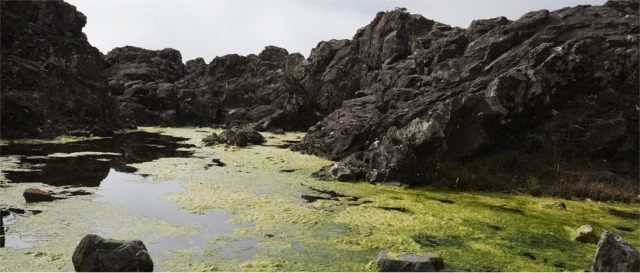Environment
Biofuels Fallacy: Why Burning Plants Instead of Fossil Fuels Won’t Save the Climate
The quest to replace black fuels with green fuels is just another resource and land grab by big corporations.
I had intended to write about why biofuel cannot be a solution to our energy problems, but found that this piece by Jeff Conant tells the tale. He interviews Jim Thomas of the ETC Group, which is a watchdog of emerging technologies. Thomas clearly explains why biofuels can never be our energy solution.
While there is no doubt that we need to kick our fossil fuel addiction, how we move to cleaner and greener ways of living is still under debate. Our first attempts at using biofuels, particularly ethanol, have been largely disastrous. But what about other plant-based fuel options? A new report from the ETC Group provides good reason to be suspicious — especially considering that the companies behind the new “green” fuels are BP, Shell, DuPont, Chevron, Syngenta, Archer Daniels Midland, Cargill and Monsanto (to name a few): the same players that brought us the petroleum economy, the food crisis and climate chaos.
Jim Thomas and his colleagues in ETC Group are consistently at the cutting edge of watch-dogging emerging technologies, from GMOs and nanotechnology to geoengineering and synthetic biology. Their critique tends to combine concern over unleashing potentially dangerous elements with a social analysis that recognizes the dynamics of power behind these technologies — who stands to benefit and who stands to lose. I spoke with Thomas about the publication of a new report by ETC Group.
Jeff Conant: You and your colleagues at ETC Group are strong advocates of taking what I would call a reasoned approach to the deployment of new technologies; you’re best known for having led the charge for a global ban on the infamous Terminator Seed, and you’ve just had a tremendous victory by winning a global moratorium on geoengineering experiments (see last week’s piece on AlterNet). Now, you’re releasing a report on another impending technological concern: synthetic biology.
Jim Thomas: The report is called “The New Biomassters: Synthetic Biology and the Next Assault on Biodiversity and Livelihoods.” It’s an exposé and argument against the new “bioeconomy” most OECD countries are now promoting as the next (supposedly “green”) wave of industrial production — switching from fossil fuels to biological material (biomass) as the key feedstock of the economy. As such, it encompasses biofuels, burning biomass for electricity, and using biomass for chemicals, plastics and other materials formerly sourced from petroleum.
JC: But isn’t this exactly what a lot of enviros want: an end to fossil fuel development in favor of renewables? What’s the concern?
JT: The bioeconomy reimagines plant life as just another source of carbon — a sort of above-ground oil reserve that can fuel the same economy we already have with just a little technological tweaking — moving from black fossil carbon to green living carbon. While that shift in carbon feedstocks may be dressed up as a green “switch,” it is in fact a red-hot imperial resource grab — on plants, land, genes and the entire “primary production” of the planet. Just as grabbing fossil carbon has displaced communities and fueled wars, so those who will suffer in the development of this new bioeconomy will be the traditional communities of the old bioeconomy. Another concern is, there is simply not enough biomass to make such a transition — indeed, industrial civilization is already taking too much.
There’s an assumption embedded in the UNFCCC and other climate policy that biomass is a carbon neutral energy source. That is wrong, dangerously so. Another mistaken assumptions is that so-called next-generation biofuels (cellulosic fuels or algae fuels) are better than the disastrous first-generation biofuels.
JC: Disastrous, in that the sudden rise in investment in biofuels led to an equally sudden displacement of food crops and helped cause the food crisis that began in 2008?
JT: That, yes; but beyond that, the point that biofuels were shown to have an equal or greater net carbon footprint than fossil fuels. I don’t think most people realize that when you burn biomass for energy you can release more CO2 than coal. Of course its assumed that CO2 will get fixed again by theoretical replacement plants over some unspecified time period, but in the process there are massive unaccounted-for greenhouse gas emissions from disturbing soils, use of fertilizers and pesticides, harvesting, transport, refining, and consuming — it can only be called disastrous.
JC: What about algal fuels? Aren’t they a way out of the biofuel dilemmas?
JT: Not really. Lifecycle analysis shows that the usual way of growing algae for fuel has a bigger greenhouse footprint than corn ethanol because there is no soil, so you need to pump a lot of fertilizer into the water. Fertilizer production is a massive energy user. Then there is the problem of land. Algae production has to be spread out thinly because sunlight doesn’t penetrate very far into algae. So you’re talking about facilities the size of San Francisco. And then there’s massive water use and the risks of invasive species and the fact that to make algae efficient you will probably need to genetically engineer it…and so on.
JC: And the other next-generation biofuels?
JT: With so-called next-generation biofuels we’re talking about expanding monoculture industrial plantations, either harvesting industrial crop wastes like rice straw and corn stover — rather than allowing them to replenish soil nutrients — or expanding tree plantations on so-called marginal lands where people actually live and subsist. Already, industrial agriculture may account for more than half of global greenhouse gas emissions. Relying further on industrial ag to meet energy demands is hardly an improvement on the fossil economy.
JC: Yet, the Obama administration has just promised increasing investment in biofuels. You say in the report that the first rush to promote “renewable fuels” and other supposedly green alternatives “was only a visible tip of a much deeper transition and trajectory in industrial policy,” which you call the bioeconomy. What do you mean by this?
JT: When OECD nations and corporate lobby groups talk about the bioeconomy they’re describing a switch from industrial feedstocks to biomass across several areas — fuels, chemicals, electricity, and beyond — everything from corn ethanol to bioplastics to biomass incineration for electricity. You know, if turning food into fuel is an unacceptable trade-off, then turning food into plastic bags is even worse. To enable this transition, they’ll need to secure stocks of biomass in the same way they previously secured oil fields and gas pipelines. For me the shocking thing was to discover that fully 86 percent of the world’s biomass is in the tropics — the global South — where it’s already sustaining the livelihoods, cultures, and basic needs of most of the world’s people. So a switch to biomass at any meaningful scale necessarily involves a corporate grab on the land and resources of the South. As with any previous industrial transition, what’s behind this is not high ideals, but the calculated interest of the corporate bottom line.
JC: Who’s behind the bioeconomy?
JT: We call them the new biomassters — but they aren’t really new. BP, Shell, DuPont, Chevron, Syngenta, Archer Daniels Midland, Cargill, Monsanto. In other words, those driving the new bioeconomy are the same inequitable and polluting industries that captain the petro-economy. There’s virtually no question that they regard the dash to biomass as a means of retooling the existing global economy without changing underlying patterns of consumption and production. If you calculate the combined worth of all the sectors that have vested interests in a new bioeconomy — energy, chemicals, agribusiness, forestry and finance corporations — you find they have a combined total worth of $17 trillion. That’s a lot of muscle.
But it’s not just the private sector; since 2008, the UN Environment Program is aggressively promoting what it’s calling the Green Economy Initiative; in 2009 the UN launched the “Global Green New Deal for a Sustainable Economy;” commodifying plantlife as a biomass carbon source is right there in the framing of the UN REDD Program (Reduction of Emissions from Deforestation and Degradation); it’s in the very concept of “ecosystem services” — the erroneous idea that we can best protect and preserve biodiversity by putting a price on it, that all of nature is at our service to use as we please.
JC: The new report broadly covers two aspects of the bioeconomy: the rush on biomass as a feedstock, and the conversion of organic matter into what you call “a platform of production” through emerging tools of synthetic biology. Can you elaborate?
JT: Synthetic biology refers to a set of “extreme genetic engineering” techniques where you insert synthetic DNA into a cell to hijack the cell’s machinery in order to produce substances that aren’t produced naturally. It’s repurposing simple cells like yeast and bacteria to create pharmaceutical products, jet fuels, polymers, synthetic foods. In the last five years, it’s moved from being a fringe science to attracting intense interest and investment. For those who want to turn plant life into high value commodities, synthetic biology is a game changer — but the game they’re changing is a game we can no longer afford to play.
JC: What are the hazards?
JT: One is, again, the land grab, or rather, an Earth grab, because ultimately the advocates of the bioeconomy are seeking to gain control over the full organic production of the planet. A second hazard is the further concentration of bio-technological power in a handful of unaccountable private interests. And of course there’s the frightening possibility of deliberate or accidental environmental release of synthetic organisms such as crops and algae, and accidental escape from the biorefineries that are already being built and operated but are little more than glorified breweries. Since organisms like E Coli, yeast, and algae are incredibly common, there’s the very real possibility of out-crossing with natural species and contamination of microbial communities in soils, seas, and animals — including us.
Perhaps most significantly, if it works, synthetic biology allows private companies to move the production of natural materials such as rubber or medicinal compounds out of the hands of farmers working in fields and into the control of private interests controlling vats of proprietary microbes. We are actually seeing that happen with a few commodities. For example, Goodyear is using synthetic biology to make rubber from synthetic yeast. If they can do that at scale it could impact the economies of rubber-producing nations such as Thailand, Malaysia and Indonesia.
JC: If switching from black energy to green energy won’t save the climate, what will?
JT: Firstly, restraint on the bloated economies of the north whose system of overproduction has fueled the collapse of biodiversity, global inequity and the climate crisis; secondly, democratic control over high-risk and unjust technologies; and thirdly, measures to protect and build the resilience of those whose ways of life actively improve things — that is, the diverse and decentralized peasant farming systems that rebuild degraded soils, reinforce food sovereignty, and strengthen community and culture. These existing bioeconomies, which are biodiversity-based rather than biomass-based, do a far better job of cooling the planet in a truly renewable way than any amount of biomass burners, biofuel refineries, or chemical factories of genetically-engineered microbes ever will.
Jeff Conant is a writer based in the San Francisco Bay Area. He is the author of A Community Guide to Environmental Health (Hesperian Foundation, 2008) and A Poetics of Resistance (AK Press, 2010). His blog for the Global Justice Ecology Project is Climate Connections
Tagged algae biofuel, algae bloom, algae climate change, biofuel, biofuel climate change, biofuel disaster, biofuel fallacy, biofuel synbio, climate change, fossil fuel biofuel, multinational corporations biofuel, multinational corporations synbio, nanotechnology, renewable energy, renewable resources, synbio, synthetic biology
















